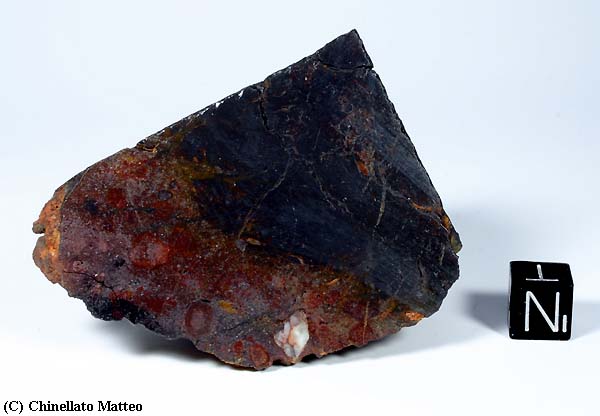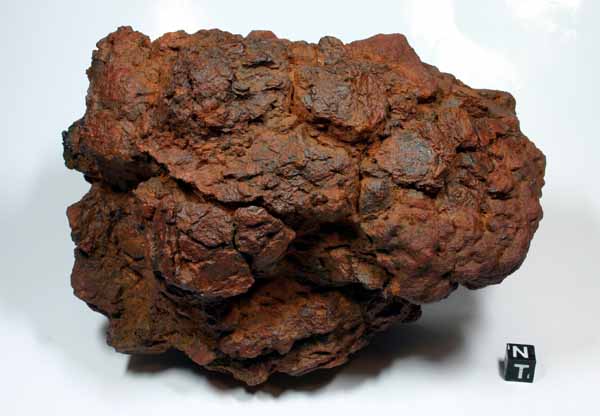- Вальтер А.А., Гуров Е.П. (1979). Установленная и предполагаемая распространённость взрывных метеоритных кратеров на Земле и их сохранность на Украинском щите // Метеоритные структуры на поверхности планет, М.: Наука, с. 126-148
- Зоткин И.Т., Дабижа А.И. (1982). Эволюция метеоритного кратера как процесс случайных перемещений // Метеоритика, Issue 40, с. 82-90
- Фельдман В.И. (1987). Каталог астроблем и метеоритных кратеров Земли // Метеоритика, Issue 46, с. 154-171
- Хрянина Л.П. (1987). Метеоритные кратеры на Земле. - Л.: Недра
- Алексеев А.С. и др. (1991). Оценки частоты падения небесных тел на Землю, исследование возможности заблаговременного их обнаружения и изменения траектори // Отчёт по НИР, АН СССР ВЦ, Новосибирск , 128 с.
- Фельдман В.И., Глазовская Л.И. (2018). Импактитогенез: учебное пособие. - М.: КДУ, - 151 с.
- O'Connell E. (1965). A catalog of meteorite craters and related features with a guide to the literature.
- Grieve R.A.F. (1987). Terrestrial impact structures // Ann.Rev.Earth Planet.Sci., Vol.15, p. 245-270
- Grieve R.A.F., Garvin J.B., Coderre J.M., Rupert J. (1989). Test of a geometric model for the modification stage of simple impact crater development // Meteoritics, Vol.24, No.2, P. 83-88
- Shoemaker E.M., Shoemaker C.S., Nishiizumi K., Kohl C.P., Arnold J.R., Klein J., Fink D., Middleton R., Kubik P.W., Sharma P. (1990). Ages of Australian meteorite craters - A preliminary report // Meteoritics, Vol.25, No.4, P. 409
- Hodge P.W., (1994). Meteorite craters and impact structures of the Earth. - Cambridge University Press , 122 рр.
- Blumberg D.G., McHone J.F., Kuzmin R., Greeley R. (1995). Radar imaging of impact craters by SIR/C/X-SAR // Lunar and Planet. Sci. Vol. 26. Abstr. Pap. 26th Lunar and Planet. Sci. Conf., March 13-17, 1995. Pt 1., Houston (Tex.), P. 139-140
- Bevan A.W.R. (1996). Australian crater-forming meteorites // AGSO J. Austral. Geol. and Geophys., Vol.16, No.4, P. 421-429
- Grieve R.A.F. (1997). Target Earth: Evidence for Large-scale // Geology, Environmental Science. - Annals of the New York Academy of Sciences. - p. 319-352. - DOI:10.1111/j.1749-6632.1997.tb48350.x
- Koeberl C. (2003). Using geochemical observations to constrain projectile types in impact cratering // LPI Contrib.(Workshop on Impact Cratering: Bridging the Gap between Modeling and Observations, Hous), No.1155, P. 45-46
- Haines P.W. (2005). Impact cratering and distal ejecta: the Australian record // Aus.Journal of Earth sciences. Vol.52, N.4/5. Aug./Oct. p.481-507
- O'Neill C., Heine C. (2005). Reconstructing the Wolfe Creek meteorite impact: Deep structure of the crater and effects on target rock // Austral. J. Earth Sci., Vol.52, No.4, P. 699-709
- Shoemaker E.M., Macdonald F.A., Shoemaker C.S. (2005). Geology of five small Australian impact craters // Austral J. Earth Sci., Vol.52, No.4, P. 529-544
- Osinski G.R. (2006). The geological record of meteorite impacts // 40th ESLAB First International Conference on Impact Cratering in the Solar System, 8-12 May 2006., Noordwijk,The Netherlands
- Poelchau M.,Kenkmann T., Kring D. (2007). The rim structure of simple craters as an indicator for an impact vector // Goldschmidt Conference Abstracts 2007, Geochimica et Cosmochimica Acta, 71 (15): Suppl. S, Aug.2007, A797.
- Glikson A. (2017). Structure and origin of Australian ring and dome features with reference to the search for asteroid impact events.
- Glikson A. (2018). Structure and origin of Australian ring and dome features with reference to the search for asteroid impact events // Tectonophysics. - V. 722. - P. 175-196.
Вольф-Крик (местоположение - Австралия, диаметр - 838*945 метров, высота вала - 30 метров) (1). Типичный пример удара по наклонной траектории с севера на юг.
(Фельдман, Глазовская, 2018).
The rims of two simple impact craters, Wolfe Creek, Australia, and Meteor Crater, AZ, USA, were examined. New methods of analysis were devised to display structural features that may be indicative of oblique impacts. Data from the two craters are compared.
Although the majority of craters are formed by oblique impacts, crater shapes remain circular for impact angles >30Ь and thus normally do not give any implications for the direction of impact. However, the ejecta blanket is the most sensitive indicator for impact angle and direction, and can show a "forbidden zone" on other terrestrial bodies.
The ejecta trajectories forming asymmetric or bilaterally symmetric ejecta blankets of oblique impacts may deviate from a radial orientation with respect to the final crater center and could probably be traced at the rim and overturned flap of simple craters, which represent the most proximal part of the ejecta. We therefore systematically analyzed strike and dip of strata in the crater rims of two young, simple impact craters, Wolfe Creek Crater and Meteor Crater.
Wolfe Creek Crater is located in Western Australia, was formed 300 ka ago and has an average diameter of 880 m. It was formed in sub-horizontal Devonian sandstones that are overlain by a layer of Miocene laterites. Meteor Crater in Arizona is 50 ka old and 1200 m in diameter. Pre-impact target rocks are sub-horizontal Permo-Triassic sandstones and limestones.
The strike data collected in both craters is translated from a geographic to an azimuthal referece scheme with the point of origin situated in the crater center. The strike of rock layers in the rim is examined for deviations from a hypothetical concentric orientation with regards to the crater center. The deviation can be expressed as an angular value for each measurement.
Results: When displayed in a polar plot, which gives a better sense of the spatial relationship, the values reveal a bilaterally symmetric orientation of the bedding and potential "forbidden zones". These preliminary results contradict earlier propositions for an impact vector in both Wolfe Creek Crater (Shoemaker et al., 2005) and Meteor Crater (Roddy & Shoemaker 1995). We intend to compare these results with other information, e.g. distribution of dip data, stereo plots and spatial relationships of bedding in three dimensions.
Acknowledgements: We would like to thank DFG for funding this project (KE 732-11/1).
(Poelchau, Kenkmann and Kring, 2007)
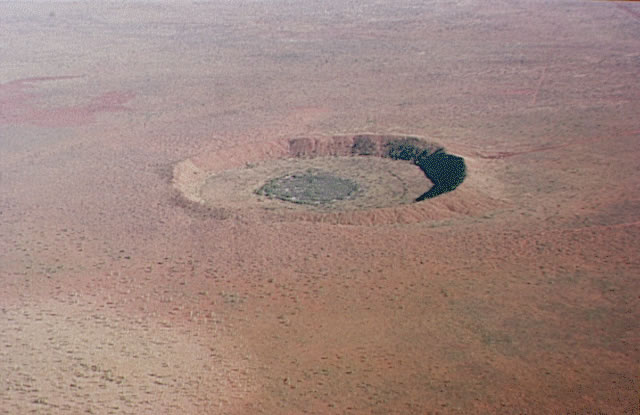
(KAUSHIK PATOWARY, 2013).
(M come Meteorite - Matteo Chinellato)
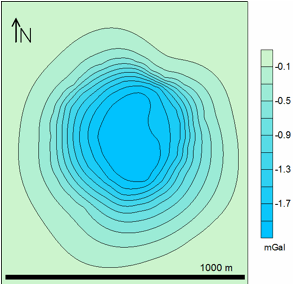
Bouguer gravity residual anomaly of the 900 m-diameter Wolfe Creek crater. Modified from Fudali (1979).
| 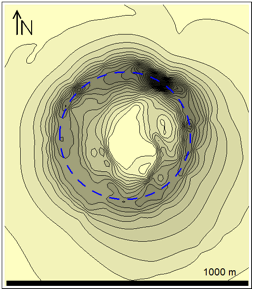
Horizontal gradient of the Wolfe Creek gravity residual anomaly. The contour of the maximum gradient (blue) describes a nearly perfect circle delineating the base of the crater inner rim.
|
(ERNSTSON CLAUDIN IMPACT STRUCTURES - METEORITE CRATERS).
Обзор статей (из РЖ ВИНИТИ "Геология и геофизика"):
Модель связывает накопление линз внутрикратерных брекчий с оползанием материала внутренних стенок переходной области в позднюю стадию образования кратера. Проверка модели сводится к сопоставлению расчетного объема внутрикратерных брекчий с объемом их, оцениваемым по результатам наблюдений в ударных кратерах Земли. Модель дает хорошее соответствие для изученных кратеров Метеор (США) и Брент [Канада]. Разумное соответствие получается также для кратеров Вест-Хок (Канада) и Лонар (Индия), для которых имеются относительно полные сведения, позволяющие оценить начальную глубину. Там же, где подобные сведения ограничиваются лишь данными гравиметрии, такого соответствия не устанавливается кратеры Ауэллул, Тенумер (Мавритания), Вульф-Крик (Австралия). В итоге авторы оценивают модель как хорошую в качестве первого приближения, но требующую проверки результатами бурения.
(Grieve, Garvin, Coderre, Rupert, 1989).
Один из известных методов датирования ударных кратеров основан на определении земного возраста метеоритов по космогенным нуклидам. Др., ныне развивающийся, основан на измерении космогенных нуклидов в земных породах in situ. Сообщается о результатах измерения (10)Be, (26)Al, (36)Cl и (41)Ca в австралийских метеоритных кратерах Боксхол, Далгарейнджа, Волф-Крик и Хенбер. Возраст кратера Вольф-Крак, определенный по (36)Cl/(10)Be и (41)Ca/(36)Cl в метеорите, равен 3*10(5) лет. Расхождение величин связано с эрозией кратера. скорость которой составляет, согласно расчетам 2*10(-3) см/год.
(Shoemaker, Shoemaker, Nishiizumi, Kohl, Arnold, Klein, Fink, Middleton, Kubik, Sharma, 1990).
Радарами SIR-C ('лямбда'-5.6; 24 см) и X-SAR ('лямбда'-3 см), размещенными на Эндеавор, (полеты в апр. и окт. 1994 г.) получены серии снимков 3 кольцевых структур: 1) Ротер-Камм (27.78 ю. ш., 16.3 в. д., диаметр D-2.6 км) видно гало, вытянутое к Ю. и З., D>2.5 км и к С. и В. D-1.5 км; 2) Жаманшин (48.33 с. ш., 61.0 в. д., D-6.5 км) видно только слабое увеличение яркости в зоне кратера, без каких-либо деталей; 3) Вольф-Крик (19.3 ю. ш., 127.77 в. д., D~0.9 км) виден рост яркости внутри кратера в направлении от Ю.-В. к С.-З.
(Blumberg, McHone, Kuzmin, Greeley, 1995).
Кратко описаны пять кратеров (Далгаранга, Виверс, Хенбери, Боксхол, Вулф-Крик), в связи с которыми известны находки метеоритного железа, характеризуемые в статье
(Bevan, 1996).
Результаты магнитных и гравитационных исследований кратера Wolfe Creek диаметром 880 м, образованного 300 тыс. лет назад, в окрестности которого найдены фрагменты метеорита. Установлено, что дно истинного кратера расположено на глубине 120 м, диаметр упавшего метеорита 12 м, время образования кратера 3, 34 с, энергия удара 0,239 Мт тротилового эквивалента. Давление на краю вала достигало 5,59-5,81 ГПа
(O'Neill, Heine, 2005).
Геологические карты и профили сечения ударных кратеров Австралии: Liverpool, Wolfe Creek, Boxhole, Veevers и Dalgaranga. Приведены особенности строения каждого кратера. Эти кратеры образовались в различных породах (от кристаллических до слабо связанных осадочных), содержат признаки падения метеоритов под разными углами и с разными скоростями. Оценено влияние этих факторов на структурную и топографическую формы небольших кратеров
(Shoemaker, Macdonald, Shoemaker, 2005).
На главную

